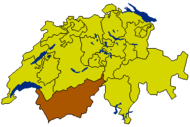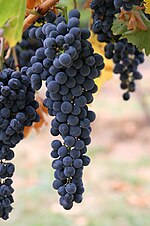Valais: Perbezaan antara semakan
Laman baru: {{terjemahan}} {{coor title dm|46|14|N|7|36|E}} {{Infobox Canton|local_names=Valais <br> Wallis|short_name=Valais| gagiföhn=Valais <br> Wallis| flag_img_path=Flag of Canton of Valais.sv... |
(Tiada perbezaan)
|
Semakan pada 07:01, 3 April 2007
Tolong bantu menterjemahkan sebahagian rencana ini. Rencana ini memerlukan kemaskini dalam Bahasa Melayu piawai Dewan Bahasa dan Pustaka. Sila membantu, bahan-bahan boleh didapati di Valais (Inggeris). Jika anda ingin menilai rencana ini, anda mungkin mahu menyemak di terjemahan Google. Walau bagaimanapun, jangan menambah terjemahan automatik kepada rencana, kerana ini biasanya mempunyai kualiti yang sangat teruk. Sumber-sumber bantuan: Pusat Rujukan Persuratan Melayu. |
46°14′N 7°36′E / 46.233°N 7.600°E
 | |
 | |
 | |
| Ibu kota | Sion |
| Keluasan | 5224 km² (Ditempatkan 3rd) |
| Titik tertinggi | Dufourspitze 4634 meter |
| Jumlah penduduk (2003) | 278,200 orang (Ditempatkan 9th) 53 /km² |
| Menyertai | 1815 |
| Singkatan | VS |
| Bahasa | French, German |
| Majlis Perundangan | Conseil d'Etat, Staatsrat (5) |
| Majlis Perundangan | Grand Conseil, Grosser Rat (130) |
| Kawasan perbandaran | 160 kawasan perbandaran |
| Daerah | 13 districts, Bezirke |
| Laman web | www.VS.ch |
 | |
The Valais (German: ![]() Wallis (bantuan·maklumat)) is one of the 26 cantons of Switzerland in the south-western part of the country, in the Pennine Alps around the valley of the Rhone River from its springs to Lake Geneva. The canton is one of the drier parts of Switzerland in its central Rhone valley. Paradoxically it is also one of the wettest parts, having large amounts of snow and rain up on the highest peaks found in Switzerland. It is perhaps best known world wide for the Matterhorn.
Wallis (bantuan·maklumat)) is one of the 26 cantons of Switzerland in the south-western part of the country, in the Pennine Alps around the valley of the Rhone River from its springs to Lake Geneva. The canton is one of the drier parts of Switzerland in its central Rhone valley. Paradoxically it is also one of the wettest parts, having large amounts of snow and rain up on the highest peaks found in Switzerland. It is perhaps best known world wide for the Matterhorn.
Geography


The canton of Valais is located in the south of Switzerland. To its south lies Italy, to the southwest France. To the north the canton is bounded by the Swiss cantons of Vaud and Bern; the cantons of Uri and Ticino lie to its east.
The wide, glacial Rhône valley dominates the area. There are many side valleys which branch off the main valley. These vary from narrow and remote to reasonably populous and popular. At the head of the Mattertal valley lies Zermatt, a pretty tourist village dominated by views of the Matterhorn (4,478 m). Fifty of the mountains exceed 4,000m with the highest, Monte Rosa, reaching to 4,638m (15,217ft), and there are numerous glaciers.
The Rhône drains the main valley from east to west up to Martigny, then in a right angle north to its mouth in the Lake Geneva. After the small town of Saint-Maurice, the northern banks of the river belong to the canton of Vaud. The main valley is bound by the Bernese Alps in the north and the Pennine Alps in the south. Only about half of the total area is considered productive.
Valleys
- North of the Rhone River
- Fieschertal
- Lötschental
- Dalatal (Leukerbad)
- South of the Rhone River:
History


The Romans called the area Vallis Poenina ("Upper Rhône Valley"). From 888 onwards the lands were part of the kingdom of Jurane Burgundy.
- Main article: Bishops of Sion.
King Rudolph III of Burgundy gave the lands to the Bishop of Sion in 999, making him Count of the Valais. The count-bishops then struggled to defend their area against the dukes of Savoy, so that the medieval history of the Valais is inextricably linked with that of the diocese of Sion.
The Valais resisted the Protestant Reformation, remaining faithful to the Roman Catholic Church. On March 12, 1529, Valais became an associate member (Zugewandter Ort) of the Swiss Confederation. In 1628 the Valais became technically a republic, the République des Sept Dizains / Republik der Sieben Zehenden under the guidance of the prince-bishop of Sion and the bailli. The bishop remained in power until 1798 when Napoleon's troops invaded the Valais and declared a Revolutionary République du Valais (March 16) which was swiftly incorporated (May 1) into the Helvetic Republic until 1802 when it became the independent Rhodanic Republic. In 1810 the Rhodanic Republic was annexed by Napoleonic France as the département of Simplon. Independence was restored in 1813 and on August 4, 1815 the Valais finally entered the Swiss confederation as a canton. In 1845 the Valais joined the Catholic separatist league (Sonderbund), but chose not to fight the troops of the confederation in 1847 and submitted to the federal forces.
Economics



Wine production and tourism are some of the main industries of the canton. The Matterhorn near Zermatt is one of the biggest tourist attractions in the Swiss mountains, as is its sister valley immediately east Saas Fee. Other parts of the mountains of the canton further west are popular as well, such as the more French speaking resorts near Verbier and the Evolene & Arolla region. The resorts on the north side of the main Rhone river valley are popular, looking out southwards towards the Peninne Alps and still part of the southern slope of the Bernese Alps, such as the family oriented resort of Crans-Montana. The resorts in the Goms region are slightly less known, yet also receive attention during the summer hiking season and the winter ski season.
Apart from tourism, agriculture is still important, particularly cattle breeding in the mountains and dairy farming in the plains. The wine industry of the canton is the largest in Switzerland. There are also a large number orchards in the area, and saffron is also gathered here.
The world's tallest gravity dam is located at Grande Dixence in the canton. Hydroelectric power plants from the canton produce about a quarter of the Swiss electricity.
Near Visp there is a large plant of aluminium manufacturing. Other metal products and chemicals are produced around Visp and Sierre. There is an oil refinery in the canton.
Despite the thriving tourist industry, high level of infrastructure, and the many vineyards, canton Valais is still one of the poorest of the Swiss cantons, and not yet near the wealthier banking/financial cantons. A large portion of the canton's land and houses is now owned by foreigners.
The mountainous canton with a plethora of ski resorts, was narrowly passed over in the bid for the last Winter Olympics.
Transport

A small airport is located at Sion, but the main routes of transport are rail and road. Both networks are extensive and benefit from tourism. There are two major rail tunnels at the Simplon and Lötschberg and a road tunnel at the Great St Bernard. Many of the road passes are well known, such as the Grimsel Pass. The longest land tunnel in the world will soon be in operation, in late 2007 perhaps, connecting by rail the town of Frutigen in canton Bern, with the town of Visp in canton Valais/Wallis. This is to better allay car traffic in the highly scenic Kandertal, and also to provide faster transport through the Bernese Alps from the populous Mittelland in the north to the southern canton of Valais. Cars may be loaded onto the trains as freight. The old train line will still likely have traffic though, as it has highly scenic sections in both cantons on either side of the old tunnel through the dividing ridgeline, yet is somewhat slower than the new route which has a much longer tunnel section.
Because of the tourism there are many mountain railways and cable cars in the mountains. The scenic rail route across the Furka Pass originates in the canton of Valais.
Demographics

Valais is predominantly French and Arpitan speaking. The eastern part of the canton Upper Valais, however, speaks German. The French speaking population makes up a little bit more than two thirds of the total population. The whole canton is thinly populated. The largest towns are the capital Sion (Sitten), Sierre and Visp. There is no major city located in the canton. Over 90% of the population is Roman Catholic.






Towns and villages
Municipalities
The following are the municipalities of the canton, by district.
See also
- Le Nouvelliste, daily
- Sion, Switzerland - Capital of the canton.
- French language
- German language
- Franco-Provençal language
External links
| Wikimedia Commons mempunyai media berkaitan Valais |
- Cantonal government (Perancis) (Jerman)
- Tourist office
- Photo database
- Official statistics
Templat:Client states of the Great French War
| Wilayah di Switzerland | |
|---|---|
| Aargau | Appenzell Ausserrhoden | Appenzell Innerrhoden | Basel-Bandar raya | Basel-Luar bandar | Berne | Fribourg | Geneva | Glarus | Graubünden | Jura | Lucerne | Neuchâtel | Nidwalden | Obwalden | Schaffhausen | Schwyz | Solothurn | St. Gallen | Thurgau | Ticino | Uri | Valais | Vaud | Zug | Zürich | |
